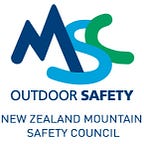Why you should always take a jacket
Other than the view, one of the most significant differences between indoors and outdoors is the impact of the weather. If it rains and you’re indoors, no problem. If it rains when you’re outdoors you’d better have a plan otherwise you’re going to get wet! Of course, experiencing the weather is one of the most engaging aspects of an outdoors adventure; you’re IN the environment engaging with it first hand.
So how do you plan for what you don’t know? The obvious solution is to check the weather. Most people know that. But which forecast? Often the urban weather forecast isn’t the most accurate for the outdoors and some people don’t know other options exist. Metservice meteorologist Lisa Murray explains.
“The weather is going to be one of the big factors in your experience outdoors, so getting a good understanding of the conditions is really important. If it’s available and relevant for your trip, you should always check the mountain forecast. The urban forecast is often not all that relevant to the mountains. This is because of the difference in altitude and the different exposure to weather on the mountain. It’s important to check the regional warnings and watches as well. These give valuable information about hazardous weather such as the intensity and timing of severe wind, heavy rain or heavy snow.”
“As you change elevation from sea level to the mountains a number of things begin to happen that will potentially have an impact on your trip. Using the Tongariro Alpine Crossing (TAC) as an example, the difference in elevation between Taupo and the summit of the track is around 1500 metres. Because of atmospheric lapse rate, the ambient temperature will be about 10°C colder at the summit than at Taupo.”
“Don’t forget that you need to factor in Wind Chill as well as this lapse rate of temperature with altitude. A rough guide to use is 2°C for every 10 km/h of wind. So if you’re in a 50 km/h of wind, you’ll need to consider an effective 10°C lower temperature. Wrapping this all together, if it’s 24°C in Taupo and you get to the summit of the TAC in a 50 km/h wind, you’ll need to have the equipment to deal with a temperature that feels like 4°C.”
One of the least understood parts of weather change in the mountains is the effect that altitude has on the atmospheric temperature. Understanding this is important because it can have a dramatic impact on the temperature you’ll need to prepare for.
MSC’s CEO Mike Daisley is keen to reinforce that ‘planning your trip’ is more than just what you’ll have for lunch.
“If you’re standing in Taupo on a nice sunny day it’s hard to visualise the conditions at the summit of the Tongariro Alpine Crossing. You often hear people saying how surprised they were that it was so cold and exposed and yet was twenty plus degrees in Taupo.”
“I’m picking on the Tongariro Alpine Crossing as it’s a good demonstration of how altitude can dramatically affect the equipment you’ll need to take and how it can alter the decisions you make. However, the effect of altitude on temperature is similar around the country.”
“After all, safety is the outcome of good planning and sensible decision making. If you know it’s going to be significantly colder at the summit, then you need a plan for that, especially if you’ve got children in the group.”
There are a few rules of thumb that indicate the temperature at various altitudes suggests Lisa Murray.
“As a guide for folks heading outdoors you should be prepared for a 7°C temperature decrease per 1000 metres rise in altitude, plus Wind Chill of about 2°C per 10 km/h of wind. That’s why you ought to think about a wind-proof jacket, gloves and a beanie, even on a nice warm day in Taupo, if you’re heading out to the TAC!”
Ready to plan your trip?
Learn More
We’ve got a whole range of resources and tools to get you up to speed for your adventures. Have fun out there!
For more information or to setup an interview please contact Nick Kingstone, Communications Manager.
marketing@mountainsafety.org.nz | 0211902930
